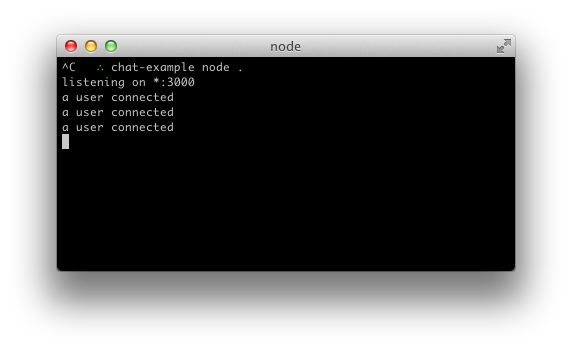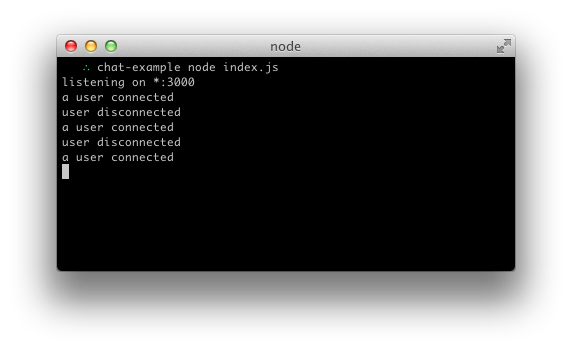Integrating Socket.IO
Socket.IO is composed of two parts:
- A server that integrates with (or mounts on) the Node.JS HTTP Server (the
socket.iopackage) - A client library that loads on the browser side (the
socket.io-clientpackage)
During development, socket.io serves the client automatically for us, as we’ll see, so for now we only have to install one module:
npm install socket.io
That will install the module and add the dependency to package.json. Now let’s edit index.js to add it:
- CommonJS
- ES modules
const express = require('express');
const { createServer } = require('node:http');
const { join } = require('node:path');
const { Server } = require('socket.io');
const app = express();
const server = createServer(app);
const io = new Server(server);
app.get('/', (req, res) => {
res.sendFile(join(__dirname, 'index.html'));
});
io.on('connection', (socket) => {
console.log('a user connected');
});
server.listen(3000, () => {
console.log('server running at http://localhost:3000');
});
import express from 'express';
import { createServer } from 'node:http';
import { fileURLToPath } from 'node:url';
import { dirname, join } from 'node:path';
import { Server } from 'socket.io';
const app = express();
const server = createServer(app);
const io = new Server(server);
const __dirname = dirname(fileURLToPath(import.meta.url));
app.get('/', (req, res) => {
res.sendFile(join(__dirname, 'index.html'));
});
io.on('connection', (socket) => {
console.log('a user connected');
});
server.listen(3000, () => {
console.log('server running at http://localhost:3000');
});
Notice that I initialize a new instance of socket.io by passing the server (the HTTP server) object. Then I listen on the connection event for incoming sockets and log it to the console.
Now in index.html add the following snippet before the </body> (end body tag):
- ES6
- ES5
<script src="/socket.io/socket.io.js"></script>
<script>
const socket = io();
</script>
<script src="/socket.io/socket.io.js"></script>
<script>
var socket = io();
</script>
That’s all it takes to load the socket.io-client, which exposes an io global (and the endpoint GET /socket.io/socket.io.js), and then connect.
If you would like to use the local version of the client-side JS file, you can find it at node_modules/socket.io/client-dist/socket.io.js.
You can also use a CDN instead of the local files (e.g. <script src="https://cdn.socket.io/4.7.5/socket.io.min.js"></script>).
Notice that I’m not specifying any URL when I call io(), since it defaults to trying to connect to the host that serves the page.
If you're behind a reverse proxy such as apache or nginx please take a look at the documentation for it.
If you're hosting your app in a folder that is not the root of your website (e.g., https://example.com/chatapp) then you also need to specify the path in both the server and the client.
If you now restart the process (by hitting Control+C and running node index.js again) and then refresh the webpage you should see the console print “a user connected”.
Try opening several tabs, and you’ll see several messages.

Each socket also fires a special disconnect event:
io.on('connection', (socket) => {
console.log('a user connected');
socket.on('disconnect', () => {
console.log('user disconnected');
});
});
Then if you refresh a tab several times you can see it in action.

- CommonJS
- ES modules
You can run this example directly in your browser on:
You can run this example directly in your browser on: